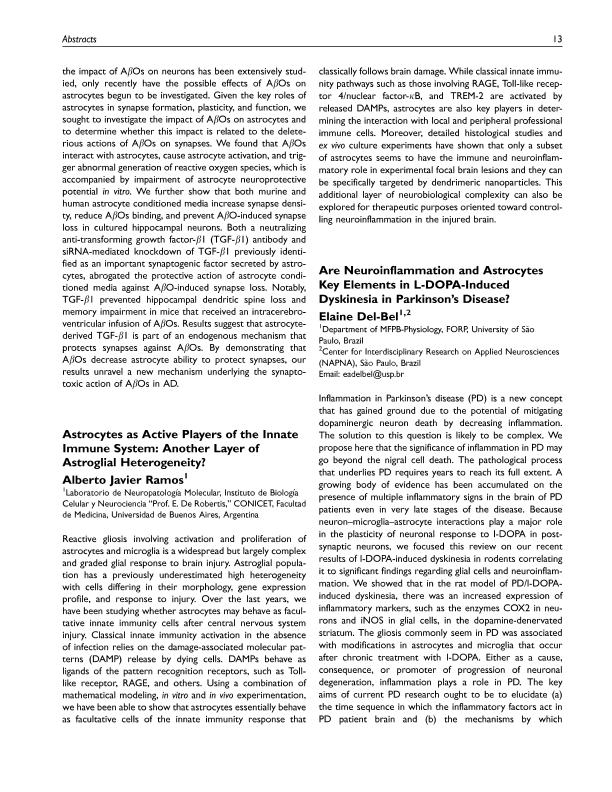Mostrar el registro sencillo del ítem
dc.contributor.author
Ramos, Alberto Javier

dc.date.available
2023-05-16T13:03:43Z
dc.date.issued
2019
dc.identifier.citation
Astrocytes as Active Players of the Innate Immune System: Another Layer of Astroglial Heterogeneity?; Reunion Anual de la Sociedad Argentina de Investigacion en Neurociencias; Argentina; 2018; 1-1
dc.identifier.uri
http://hdl.handle.net/11336/197656
dc.description.abstract
Reactive gliosis involving activation and proliferation ofastrocytes and microglia is a widespread but largely complexand graded glial response to brain injury. Astroglial populationhas a previously underestimated high heterogeneitywith cells differing in their morphology, gene expressionprofile, and response to injury. Over the last years, wehave been studying whether astrocytes may behave as facultativeinnate immunity cells after central nervous systeminjury. Classical innate immunity activation in the absenceof infection relies on the damage-associated molecular patterns(DAMP) release by dying cells. DAMPs behave asligands of the pattern recognition receptors, such as Tolllikereceptor, RAGE, and others. Using a combination ofmathematical modeling, in vitro and in vivo experimentation,we have been able to show that astrocytes essentially behaveas facultative cells of the innate immunity response that classically follows brain damage.While classical innate immunitypathways such as those involving RAGE, Toll-like receptor4/nuclear factor-jB, and TREM-2 are activated byreleased DAMPs, astrocytes are also key players in determiningthe interaction with local and peripheral professionalimmune cells. Moreover, detailed histological studies andex vivo culture experiments have shown that only a subsetof astrocytes seems to have the immune and neuroinflammatoryrole in experimental focal brain lesions and they canbe specifically targeted by dendrimeric nanoparticles. Thisadditional layer of neurobiological complexity can also beexplored for therapeutic purposes oriented toward controllingneuroinflammation in the injured brain.
dc.format
application/pdf
dc.language.iso
eng
dc.publisher
SAGE Publications

dc.rights
info:eu-repo/semantics/openAccess
dc.rights.uri
https://creativecommons.org/licenses/by-nc-sa/2.5/ar/
dc.subject
GLIA
dc.subject
ischemia
dc.subject
neuroinflammation
dc.subject.classification
Otras Ciencias Médicas

dc.subject.classification
Otras Ciencias Médicas

dc.subject.classification
CIENCIAS MÉDICAS Y DE LA SALUD

dc.title
Astrocytes as Active Players of the Innate Immune System: Another Layer of Astroglial Heterogeneity?
dc.type
info:eu-repo/semantics/publishedVersion
dc.type
info:eu-repo/semantics/conferenceObject
dc.type
info:ar-repo/semantics/documento de conferencia
dc.date.updated
2022-11-25T00:23:13Z
dc.journal.pagination
1-1
dc.journal.pais
Estados Unidos

dc.journal.ciudad
Seattle
dc.description.fil
Fil: Ramos, Alberto Javier. Consejo Nacional de Investigaciones Científicas y Técnicas. Oficina de Coordinación Administrativa Houssay. Instituto de Biología Celular y Neurociencia "Prof. Eduardo de Robertis". Universidad de Buenos Aires. Facultad de Medicina. Instituto de Biología Celular y Neurociencia; Argentina
dc.relation.alternativeid
info:eu-repo/semantics/altIdentifier/url/https://journals.sagepub.com/doi/pdf/10.1177/1759091419834821
dc.conicet.rol
Autor

dc.coverage
Internacional
dc.type.subtype
Congreso
dc.description.nombreEvento
Reunion Anual de la Sociedad Argentina de Investigacion en Neurociencias
dc.date.evento
2018-10-24
dc.description.paisEvento
Argentina

dc.type.publicacion
Journal
dc.description.institucionOrganizadora
Sociedad Argentina de Neurologia
dc.source.revista
ASN Neuro
dc.date.eventoHasta
2018-10-26
dc.type
Congreso
Archivos asociados
